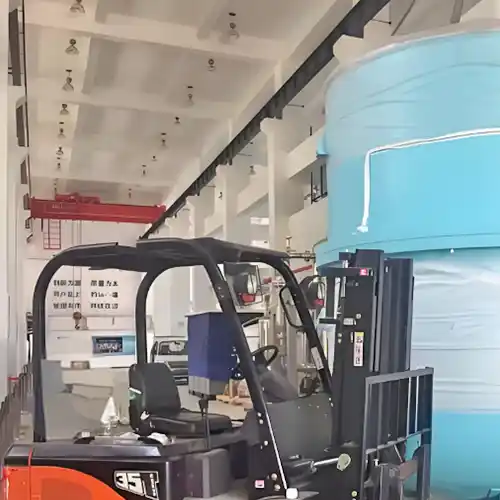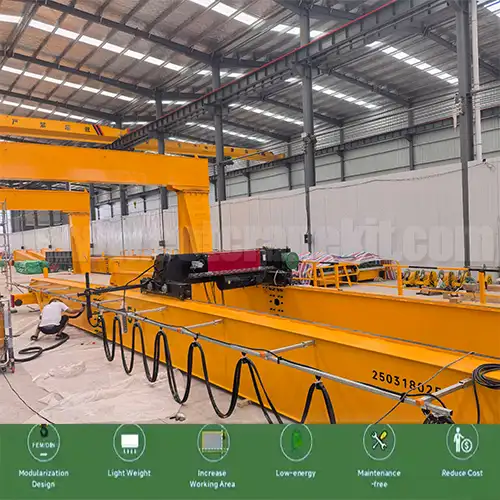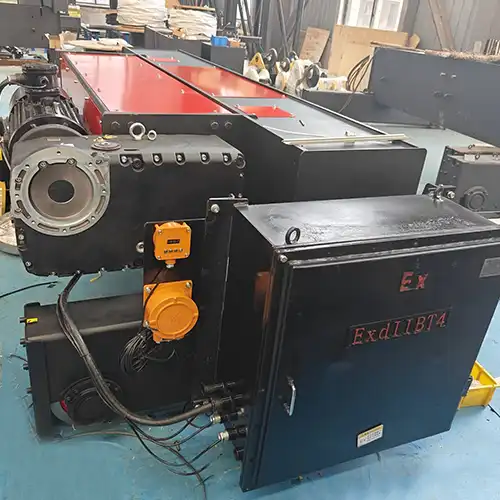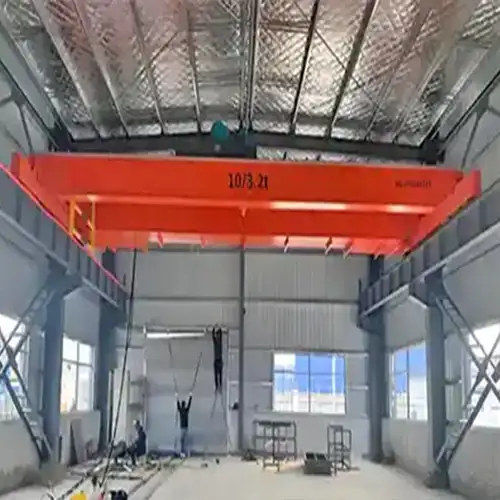Explosion-Proof Overhead Cranes for Safe Boiler Handling
Explosion-proof overhead cranes, with capacities up to 100 tons, ensure safe handling of boilers in hazardous environments, preventing ignition risks.
Category: Hazardous Environment Cranes
Your Trusted Explosion Proof Overhead Crane Manufacturer & Supplier
Explosion-Proof Overhead Cranes for Safe Boiler Handling
Explosion-Proof Overhead Cranes for Safe Boiler Handling: Capacity, Features, and Applications
Explosion-proof overhead cranes, with capacities up to 100 tons, ensure safe handling of boilers in hazardous environments, preventing ignition risks.
The Need for Explosion-Proof Cranes in Boiler Handling
In many industrial settings, such as heating plants, power stations, and large manufacturing facilities, boilers are essential for generating heat and power. However, these environments often present a serious safety risk due to the presence of flammable gases and combustible vapors, which can accumulate during the operation of boilers. Boilers, particularly those running on fuels like natural gas, oil, or biomass, create a combustible atmosphere that can be dangerous if not properly managed.
In these environments, overhead cranes are required to handle heavy boiler components during installation, maintenance, or removal. However, standard cranes can pose a significant hazard. The mechanical and electrical components in typical cranes can potentially create sparks, excessive heat, or electrical failures, all of which could ignite the surrounding flammable gases and lead to a catastrophic fire or explosion.
Explosion-proof cranes are specifically designed to mitigate these risks. These cranes are built with safety features that prevent sparks, control temperature, and ensure that electrical systems do not emit any hazardous heat or arcing. They are engineered to meet strict safety standards, such as ATEX (European) and IECEx (international), making them suitable for use in environments with combustible materials.
How Explosion-Proof Cranes Ensure Safe Boiler Handling
The primary function of an explosion-proof crane is to prevent ignition in environments where flammable gases or vapors are present. In boiler rooms, the combustion process can lead to the release of flammable gases like natural gas, propane, or hydrogen. These gases can accumulate in the air and create a hazardous atmosphere. If any equipment, including a traditional crane, creates a spark or excessive heat during operation, it could trigger a dangerous fire or explosion.
Explosion-proof cranes are designed to operate safely in these high-risk areas by incorporating several key safety features:
- Sealed Electrical Components: To prevent sparks or electrical arcs from escaping, all electrical components in explosion-proof cranes are fully sealed.
- Spark-Proof Enclosures: Key parts of the crane, such as motors and switches, are housed in flameproof enclosures that eliminate the risk of ignition.
- Temperature Control: Over-temperature protection systems ensure that no part of the crane becomes hot enough to ignite the surrounding gases.
By ensuring that the crane operates without generating heat or sparks, these explosion-proof models allow safe handling of large boiler components, including burners, heat exchangers, and valves, during installation, repair, and maintenance.
The Importance of Explosion-Proof Cranes in Hazardous Environments
When handling large and heavy boiler components, precision is key. Explosion-proof cranes ensure that these operations are carried out without the added risk of fire or explosion. Whether it's the installation of a new boiler, removal of an old unit, or performing routine maintenance, these cranes help to safely move components in high-risk environments.
Explosion-proof cranes are essential for ensuring that workers remain safe and that facilities continue to operate without interruption. They are a vital safety measure in industries where the presence of combustible gases is common and where traditional cranes would pose a serious threat.
In conclusion, explosion-proof cranes in boiler handling provide the peace of mind and safety necessary for operating in environments where the presence of flammable gases is a constant concern. Their design eliminates the risk of ignition, ensuring safe and efficient handling of boiler components, and ultimately safeguarding personnel and infrastructure.
Why Explosion-Proof Cranes Are Necessary for Boiler Handling
Risks of Hazardous Atmospheres in Boiler Rooms
Boiler rooms are critical environments in industries such as power generation, manufacturing, and heating plants, where boilers are used to produce steam or heat for various processes. These rooms often rely on combustible fuels like natural gas, oil, or propane, which are burned to generate heat. While these fuels are essential for operation, they also create a significant safety concern: the accumulation of flammable gases.
During the combustion process, gases like carbon monoxide, methane, or hydrogen can escape into the air, especially if there are leaks or pressure fluctuations. If not properly ventilated, these gases can accumulate in confined spaces like boiler rooms, creating an atmosphere that is highly susceptible to ignition. Even a small spark, heat source, or electrical fault can trigger a dangerous explosion or fire.
This is where explosion-proof cranes become essential. These specialized cranes are designed to operate safely in environments where these hazardous gases are present. Unlike standard cranes, explosion-proof models are equipped with features that prevent sparks or heat from escaping and igniting the surrounding atmosphere. By using explosion-proof cranes, industrial facilities ensure that they can safely handle boiler components without the risk of sparking a fire or explosion.
Explosion Risk in Boiler Handling
Handling large, heavy boiler components involves a variety of movements, such as lifting, positioning, and rotating. These operations can generate mechanical friction, sparks, or electrical heat, all of which could ignite nearby flammable gases in the environment. In boiler rooms, where gases like natural gas or propane are common, even minor sparks from mechanical systems or electrical components can be catastrophic.
The explosion risk increases when cranes are used for tasks like boiler installation, maintenance, or removal, where components are often moved through confined spaces, requiring precise and repeated movements. If any part of the crane's motor, electrical system, or mechanical structure overheats or creates an electrical arc, it could trigger an explosion in an atmosphere that contains flammable gases.
Explosion-proof cranes are specifically engineered to address these risks. They feature:
- Sealed Motors: To prevent any sparks or electrical arcs from escaping, explosion-proof cranes are equipped with sealed motors that are fully enclosed and shielded from the hazardous environment.
- Spark-Proof Enclosures: Key electrical and mechanical components of the crane, such as motors, switches, and connectors, are housed in specially designed enclosures that prevent any external ignition sources from escaping.
- Temperature-Controlled Systems: These cranes include cooling or temperature-regulation mechanisms that prevent components from overheating, which could otherwise generate the heat needed to ignite flammable gases in the atmosphere.
By employing explosion-proof cranes, companies can mitigate the risk of fire or explosion while handling heavy, delicate boiler components in environments that could otherwise pose serious dangers. These cranes help ensure that the operation proceeds smoothly and safely, even in hazardous conditions.
In summary, the risks of hazardous atmospheres in boiler rooms—combined with the potential for mechanical or electrical ignition—make explosion-proof cranes a necessary investment for ensuring safety, compliance, and operational efficiency in these high-risk environments.
Key Reasons for Using Explosion-Proof Cranes in Boiler Handling
Presence of Flammable Gases
Boiler rooms are environments where flammable gases such as natural gas, hydrogen, propane, and other volatile compounds can accumulate. These gases may result from combustion processes or gas leaks, increasing the risk of explosions or fires. To mitigate this risk, explosion-proof cranes are designed to operate without triggering ignition in these hazardous areas.
- Containment of Sparks: Explosion-proof cranes are built with specialized components to prevent sparks that could ignite the surrounding gases.
- Minimized Heat Buildup: These cranes are designed to limit heat production from electrical or mechanical components, reducing the chance of ignition.
- Safe Electrical and Mechanical Systems: The motors, cables, and other electrical systems are sealed to prevent any sparks from escaping into the environment.
By incorporating these features, explosion-proof cranes can safely handle heavy boiler components in environments with high concentrations of flammable gases.
Hazardous Environments in Boiler Rooms
Boiler rooms are classified as hazardous zones where combustible materials and gases are present. To operate safely in these zones, equipment such as explosion-proof cranes must meet stringent safety certifications and standards.
- ATEX and IECEx Standards: Explosion-proof cranes are built to meet ATEX (Europe) or IECEx (International Electrotechnical Commission) standards for operation in hazardous areas.
- OSHA Compliance: In the U.S., cranes used in Class I, Division 1 areas must meet strict safety requirements to ensure safe operation in hazardous environments.
- Zone Ratings: These cranes are rated for Zone 1 or Zone 2 (ATEX) or Class I, Division 1 (OSHA), making them suitable for high-risk environments where flammable gases or vapors are present.
These certifications ensure that explosion-proof cranes can operate safely in the most dangerous boiler room settings.
Preventing Sparks and Heat Generation
One of the major risks in boiler rooms is the potential for sparks or heat generation from crane components that could ignite flammable gases or vapors. Explosion-proof cranes are equipped with features that significantly reduce this risk.
- Sealed Electrical Systems: The electrical components are fully enclosed to prevent any sparks from escaping into the surrounding atmosphere.
- Flameproof Enclosures: Critical crane components, such as motors and switches, are housed in flameproof enclosures that prevent internal sparks or heat from reaching the external environment.
- Temperature-Regulated Components: Temperature-controlled systems help prevent overheating of crane components, ensuring stable operation in high-risk environments.
These safety measures are critical in maintaining a safe operating environment in boiler rooms where the risk of ignition is high.
Maintaining Operational Safety
Explosion-proof cranes are designed to ensure safe and reliable operation while handling heavy boiler components, even in confined or high-risk environments. Their construction allows them to perform efficiently without compromising safety.
- Heavy Load Handling: These cranes are engineered to lift large, heavy boilers with precision, even in tight spaces.
- Durability and Reliability: Explosion-proof cranes are built to handle continuous operation in hazardous environments with minimal risk of malfunction.
- Minimal Maintenance: The robust design ensures that the cranes require less frequent maintenance, reducing the risk of failure during critical operations.
By ensuring safe handling and operation, these cranes play a vital role in maintaining safety during boiler handling tasks.
In conclusion, the key reasons for using explosion-proof cranes in boiler handling are:
- Preventing ignition risks due to flammable gases.
- Compliance with strict safety standards for hazardous environments.
- Minimizing sparks and heat generation through sealed and flameproof systems.
- Ensuring reliable and safe operation even in high-risk, confined spaces.
Explosion-proof cranes are an essential safety tool for the safe handling of boilers in environments where the risks of fire or explosion are present.
Types of Explosion-Proof Cranes for Boiler Handling
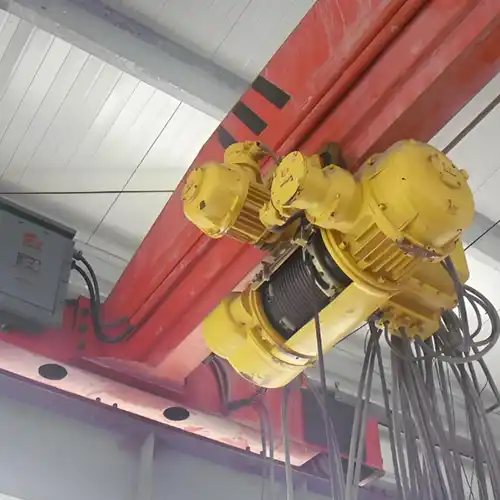
Single Girder Explosion-Proof Cranes
Single girder explosion-proof cranes are designed for smaller boilers and less complex operations. These cranes are ideal when space is limited, making them suitable for environments where the available room for crane movement is constrained.
- Lifting Capacity: Typically up to 10-20 tons.
- Applications: Used in smaller boiler rooms, auxiliary systems, or moderate risk environments, such as plants where the risk of explosion is present but not as severe.
- Features: These cranes are compact, cost-effective, and easy to install, making them a good option for facilities with space constraints.
- Safety: Even though the risk is moderate, explosion-proof features are still essential to prevent the ignition of flammable gases or vapors.
Single girder cranes are ideal for less demanding applications where precision and compactness are important, but the need for extreme lifting capacity is low.

Double Girder Explosion-Proof Cranes
Double girder explosion-proof cranes are designed for larger industrial-scale boilers that require higher lifting capacities. These cranes offer greater stability and control, making them the preferred option for handling heavy and bulky components found in large boiler systems.
- Lifting Capacity: Typically up to 100 tons or more.
- Applications: Ideal for large plants, refineries, and heating systems where high lifting capacity is crucial. Commonly used in environments where larger boilers or complex components need to be handled.
- Features: Double girder cranes provide enhanced structural support, which is necessary when lifting heavy, large components in hazardous environments. The design ensures smooth operation even with challenging loads.
- Safety: These cranes are equipped with advanced explosion-proof technology to prevent any ignition risks, even under high-stress conditions.
Double girder explosion-proof cranes are critical for operations where large-scale boiler handling is required and where higher lifting capacities are essential for both safety and operational efficiency.
Explosion-Proof Jib Cranes
Explosion-proof jib cranes are perfect for localized handling of smaller boiler components that require high precision and maneuverability. These cranes are typically used in tight spaces, making them ideal for environments where overhead clearance is limited.
- Lifting Capacity: Varies depending on the size and design but is typically lower than single or double girder cranes.
- Applications: Commonly used for specific tasks such as positioning smaller parts of a boiler (e.g., burners, pumps, heat exchangers), or lifting auxiliary components that require more precision.
- Features: Jib cranes are designed to operate in confined spaces with limited headroom, providing a high degree of flexibility for tasks that require precision lifting in restricted areas.
- Safety: The explosion-proof design ensures that no sparks or heat are generated during the operation, protecting both the equipment and the personnel working in hazardous environments.
Explosion-proof jib cranes are essential when localized handling and maneuverability are required, especially in confined or hazardous environments where space is a limitation.
Custom Explosion-Proof Cranes
Custom explosion-proof cranes are tailored solutions designed to meet the unique needs of specific boiler handling tasks. These cranes are built to address the particular challenges posed by different boiler sizes, plant layouts, or handling requirements.
- Lifting Capacity: Custom capacities depending on specific needs, often greater than 100 tons.
- Applications: Used in specialized facilities, where standard crane designs do not meet the operational requirements. Ideal for environments where boiler handling involves unconventional tasks or requires additional safety features.
- Features: Custom features may include special lifting accessories, bespoke hoisting systems, or enhanced safety measures such as automatic shutdown systems or more robust sealing systems for harsh environments.
- Safety: These cranes are built to comply with ATEX and IECEx certifications, ensuring they can operate safely in high-risk environments where off-the-shelf solutions might not suffice.
Custom explosion-proof cranes offer flexibility and reliability for operations where standard crane models cannot fully meet the specific needs of a boiler handling task.
Key Features of Explosion-Proof Cranes for Boiler Handling
Load Capacity
- Small Boilers: Explosion-proof cranes with capacities up to 10-20 tons are ideal for handling smaller boilers typically found in auxiliary systems or less complex boiler rooms.
- Industrial Boilers: For large, industrial boilers, cranes with lifting capacities of up to 100 tons or more are essential to safely handle the heavier and bulkier loads.
- Capacity Selection: When selecting an explosion-proof crane, it is critical to choose one that matches the weight and size of the boiler being handled. This ensures both safety and efficiency in operation, as improperly sized cranes could strain the system and pose safety risks.
Explosion-Proof Components
- Explosion-Proof Electrical Systems: To minimize ignition risks, explosion-proof cranes are equipped with specialized electrical systems designed to prevent sparks from igniting flammable gases in the environment.
- Sealed Motors and Flameproof Enclosures: These components ensure that no part of the crane can release sparks or heat that might ignite surrounding gases. Sealed motors, flameproof enclosures, and explosion-proof winches are integral to the safe operation of cranes in hazardous environments.
- Explosion-Proof Winches: Winches, being crucial for lifting, are specially designed to ensure that no sparks are emitted during operation, further preventing any ignition hazard.
By incorporating these explosion-proof components, cranes significantly reduce the risk of ignition and enhance safety in environments where flammable gases are present.
Temperature Regulation
- Temperature-Controlled Electrical Systems: In boiler handling, temperature regulation is key, especially given the high heat environments common in boiler rooms. Explosion-proof cranes feature temperature-controlled electrical systems that prevent overheating during operation.
- Temperature-Regulated Motors: Motors are equipped with built-in temperature control to ensure they do not overheat, thus avoiding the possibility of generating sparks or ignition. This is particularly important in high-heat environments, where heat from the boiler can affect crane performance.
Temperature regulation ensures continuous operation without compromising safety, maintaining crane performance even in high-temperature environments.
Operational Features
- Precision and Control: Explosion-proof cranes often come with advanced speed control systems and fine positioning technology. These features allow for precise lifting and placement of heavy and delicate boiler components, ensuring accurate handling and reducing the likelihood of accidents during the operation.
- Remote Control Options: In hazardous environments, explosion-proof cranes are equipped with remote control systems that allow operators to control the crane from a safe distance. This not only keeps operators away from potential ignition sources but also minimizes human exposure to risky areas, improving overall operational safety.
These operational features, such as remote control systems and fine positioning, allow for greater safety and efficiency in boiler handling operations, ensuring both precision and protection.
Typical Applications of Explosion-Proof Cranes in Boiler Handling
Boiler Installation
- Lifting and Positioning: Explosion-proof cranes play a crucial role in lifting and positioning large boilers during installation, particularly in hazardous environments like boiler rooms or industrial plants with the risk of flammable gases.
- Specialized Lifting Beams: Cranes are equipped with special lifting beams and spreader bars that ensure even weight distribution when handling heavy boiler components, preventing damage and ensuring precise placement during installation.
- Safe Handling: By using explosion-proof cranes, the installation process becomes safer by minimizing ignition risks and ensuring that all components are lifted and positioned securely.
Routine Maintenance and Inspections
- Lifting Components: Explosion-proof cranes are used extensively during routine boiler maintenance. They handle and lift various boiler components, such as heat exchanger tubes, burners, and valves, for regular inspections or servicing.
- Precision and Care: Cranes ensure that delicate components are handled carefully to avoid damage. Maintenance tasks are made safer and more efficient with cranes designed to operate in hazardous atmospheres, where spark-free operation is critical.
- Minimizing Downtime: By providing safe lifting for maintenance activities, explosion-proof cranes help reduce downtime and improve plant reliability.
Boiler Removal and Replacement
- Precision in Removal: During the removal or replacement of old boilers, explosion-proof cranes provide the precision required to carefully lift and maneuver large, heavy boilers out of place without damaging the surrounding structure or equipment.
- Hazardous, Confined Spaces: Many boilers are located in confined spaces or areas with limited access. Explosion-proof cranes are essential for navigating these challenging environments, where sparks or heat generation could cause ignition.
- Heavy Lifting: Cranes are equipped to handle the weight and bulk of industrial boilers, ensuring that they can safely move large components even in high-risk environments.
Emergency Repairs
- Unplanned Downtime: In cases of boiler failure or other emergency repairs, explosion-proof cranes are used to position components for urgent repairs or inspections, minimizing plant downtime.
- Quick Response: These cranes ensure that critical parts can be moved and replaced swiftly, reducing the impact of unplanned failures on overall plant operations.
- Safety in Emergency Conditions: Since emergency repairs often occur in hazardous conditions, explosion-proof cranes guarantee safe operations even when the environment is volatile or risky.
Explosion-proof cranes are indispensable in each of these boiler handling tasks, providing the safety, precision, and reliability required for working in hazardous environments. Whether for installation, maintenance, removal, or emergency repairs, they ensure that boiler handling is done with minimal risk to personnel and equipment.

Customized overhead bridge crane for your material handling
How to Select an Explosion-Proof Crane for Your Boiler Handling Needs
Capacity and Load Requirements
Determine the Weight and Size of the Boiler: The most critical factor in selecting an explosion-proof crane is its load capacity. Choose a crane that can safely handle the weight and size of the boiler you intend to lift.
- Larger Boilers: For heavy, industrial-scale boilers, double girder cranes are recommended. These cranes offer higher lifting capacities (typically up to 100 tons or more) and greater stability.
- Smaller Boilers: For smaller units, such as those in auxiliary systems, a single girder crane or a jib crane may be sufficient, as they are designed for lower capacity lifts (usually up to 10-20 tons).
Space Constraints and Design
Assess Available Space: Before selecting a crane, evaluate the space in your boiler room or facility. Tight spaces may require more compact crane designs.
- Limited Space: In confined areas, jib cranes or customized solutions may be necessary. These cranes are designed for localized lifting and can fit into areas with limited headroom or space.
- Longer Reach or Higher Capacity: In larger boiler rooms with more space, double girder cranes can operate more freely, offering better reach and higher capacity.
Hazardous Area Classification
Understand the Hazardous Area Classification: Boiler rooms are often hazardous environments where flammable gases, vapors, or combustible dusts can accumulate. The crane must be certified to operate safely in these conditions.
- ATEX and IECEx Certifications: Ensure the crane meets ATEX (Europe) or IECEx (International) standards for hazardous area operations.
- Class and Zone Classification: Determine if your facility is Zone 1 or Zone 2 (ATEX) or Class I, Division 1 (OSHA). Select a crane that is rated and certified for the specific zone classification of your boiler room.
Customization Needs
Evaluate Custom Features: For facilities with unique layouts or complex boiler handling needs, custom cranes may be required.
Specialized Lifting Beams and Hoisting Accessories: Some operations may require customized lifting beams, spreader bars, or hoisting systems to ensure safe and effective lifting of specific boiler components.
- Remote Operation: If personnel need to be kept away from hazardous areas, cranes with remote control systems allow operators to control the crane from a safe distance.
- Tailored Solutions: Custom cranes are also helpful for handling non-standard boiler sizes or navigating complex plant layouts.
Compliance with Safety Standards
Verify Compliance: Ensuring that the crane complies with both local and international safety regulations is vital for safe operation in hazardous environments.- OSHA, ATEX, IECEx: Verify that the crane meets safety standards such as OSHA (for U.S. facilities), ATEX, and IECEx to ensure that it will operate safely in explosive or combustible atmospheres.
- Periodic Inspections: Choose a crane that complies with ongoing inspection requirements, as safety compliance must be maintained throughout the crane's lifecycle.
Selecting the right explosion-proof crane for boiler handling involves assessing several factors, including load capacity, space constraints, hazardous area classification, customization needs, and safety compliance. By carefully evaluating these aspects, you can ensure that you choose the most suitable crane for safe and efficient boiler handling in your facility.
Compliance with Safety Regulations
Safety Standards and Certifications
International Safety Standards: Explosion-proof cranes used in boiler handling must comply with stringent safety regulations to ensure safe operation in hazardous environments. The most common certifications include:
- ATEX (Atmosphère Explosible): Required for use in explosive atmospheres in Europe, ensuring the crane is designed to prevent ignition in environments with flammable gases or dust.
- IECEx (International Electrotechnical Commission Explosion Protection): International certification for equipment used in explosive atmospheres, confirming the crane meets safety standards for hazardous areas worldwide.
- OSHA (Occupational Safety and Health Administration): In the United States, OSHA regulations ensure that equipment used in hazardous areas, like boiler rooms, meets safety standards for preventing workplace accidents and exposure to combustible materials.
Local Regulations: Besides international standards, ensure the crane meets local safety regulations specific to the location where it will be used. These regulations can vary depending on the type of operation, the potential hazards, and the local legal framework.
Explosion-Proof Classification: Cranes must also be classified according to the zone or class of the hazardous environment they will operate in (e.g., Zone 1 or Zone 2 (ATEX), Class I, Division 1 (OSHA)). Selecting a crane certified for the appropriate classification ensures it is safe to use in environments where combustible gases, vapors, or dusts are present.
Routine Inspections and Testing
Regular Safety Inspections: To maintain compliance with safety regulations, explosion-proof cranes must undergo periodic safety inspections. These inspections are crucial to identify any potential issues before they cause accidents or equipment failure.
- Visual Inspections: Check for visible signs of wear, corrosion, or damage, especially on explosion-proof components such as seals, motors, and enclosures.
- Functional Testing: Ensure that all parts of the crane, including motors, electrical systems, and lifting mechanisms, are functioning correctly and safely.
Load Testing: Regular load testing ensures the crane can safely lift the intended weight without exceeding its rated capacity. This is essential to ensure the crane operates within its safe working limits.
Safety Checks: In addition to functional and load testing, safety systems such as emergency stop switches, limit switches, and brake systems must be tested regularly to ensure they are fully operational.
Documentation and Reporting: Keep detailed records of inspections, tests, and any maintenance or repairs performed on the crane. These records are often required by regulatory bodies and serve as proof of compliance with safety standards.
Preventive Maintenance: Implement a preventive maintenance program to detect and address potential issues before they lead to safety concerns. Regular lubrication, parts replacement, and electrical system checks contribute to maintaining the crane's safety and reliability.
Ensuring that your explosion-proof crane meets the relevant safety regulations and undergoes routine inspections and testing is critical for maintaining a safe working environment in boiler rooms and other hazardous areas. By adhering to these guidelines, you minimize the risk of accidents, ensure operational efficiency, and comply with international and local safety standards.
Conclusion
Explosion-proof overhead cranes play a vital role in ensuring safe and efficient boiler handling in environments where combustible gases or vapors are present. These environments, such as boiler rooms and industrial heating plants, often involve the use of fuels like natural gas, propane, or oil, which can create hazardous conditions that increase the risk of fires and explosions. Explosion-proof cranes are designed to mitigate these risks by incorporating specialized features like sealed motors, flameproof enclosures, and spark-proof electrical systems.
The primary benefits of these cranes include:
- Operator Safety: By preventing ignition of flammable gases, explosion-proof cranes protect workers from life-threatening accidents.
- Regulatory Compliance: These cranes ensure that operations comply with local and international safety standards, including ATEX, IECEx, and OSHA.
- Operational Efficiency: Explosion-proof cranes enable precise lifting, installation, and maintenance of heavy boiler components, even in challenging, confined spaces.
In summary, explosion-proof cranes are indispensable in boiler handling applications, ensuring that operations remain safe, compliant, and efficient, while significantly reducing the risk of catastrophic accidents and costly downtime.
Related Products
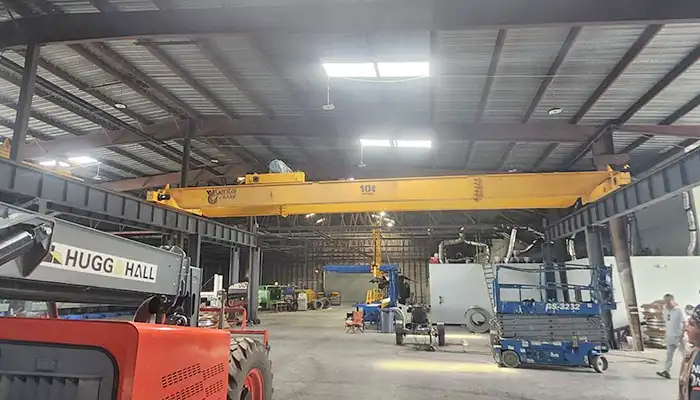
Affordable 10 ton double girder overhead crane with CD/MD hoist trolley, built for U.S. standards, ideal for construction and industrial lifting
Free consultation to Confirm Parameters & Specifications and Get
Latest Crane Price & Crane Rate.
- Types of overhead cranes : _______?
- Optional: Overhead travelling crane, goliath gantry crane,Slewing jib crane, Single girder or double girder crane,small portable crane or kbk crane, etc.
- Capacity of overhead crane: _______?
- Optional: 0.25ton, 0.5 ton, 1 ton, 2 ton, 3ton, 5 ton, 10 ton,15ton, 20ton, 25 ton, 30ton,35ton, up to 550ton, etc.
- Crane span & lifting height : _______?
- Crane travelling length : _____?
- Control of overhead crane:_______?
- Optional: pendant/ remote/cabin control
- Voltage supply of overhead crane:_____?
- Eg,: 380V50/60HZ,3Phase or others,etc.
- Application/usage of crane:_______?
- Eg,: Steel mill, ,injection mold, cement,stone, concrete,granite, general manufacturing, etc.
Just leave a message via the contact form and our hoist and crane engineer will contact you with in 24working hours.
Get In Touch
